Discover the Best Pergola Plants for your garden and train these climbing plants on structures. They can also be grown in large containers!
There are many climbing plants that can be trained to climb over to get a welcoming shade in warm weather and colors, you can also use them to improve privacy and remove dullness from any outdoor space.
Check out our article on the best climbing houseplants here
Best Pergola Plants
1. Rose
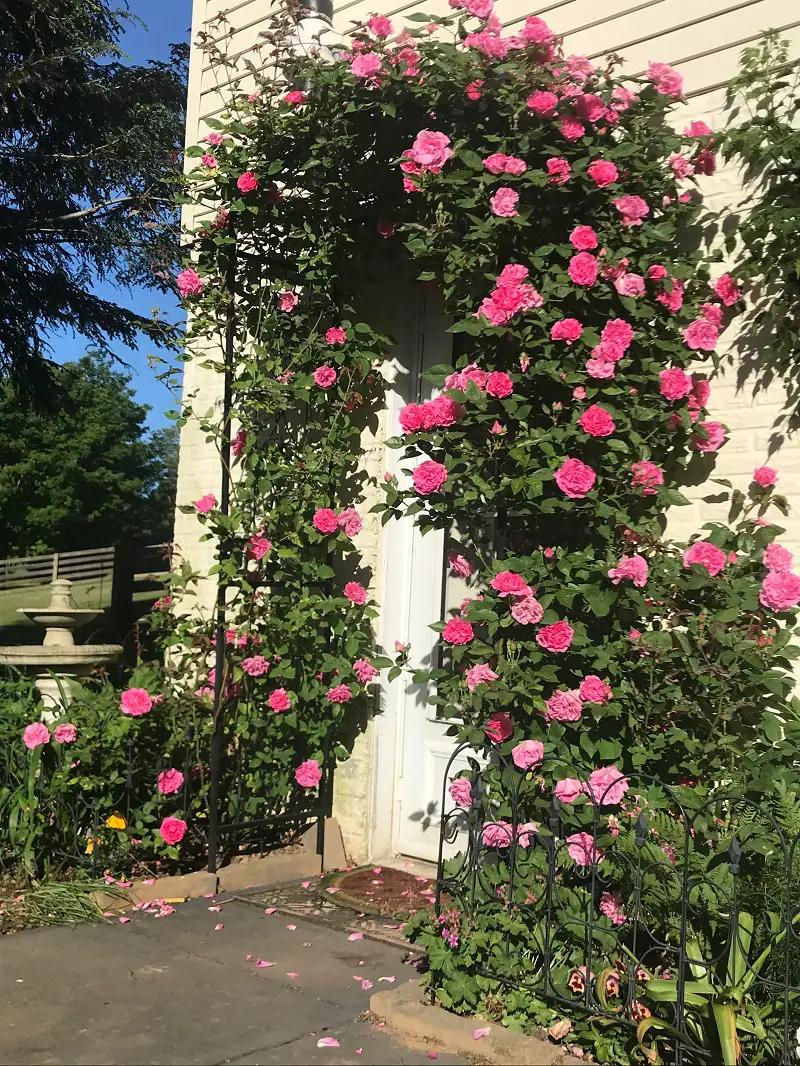
Botanical Name: Rosa
Roses are the favorite plants of most gardeners as they give out a feeling of warmth, tranquility, nostalgia, romance, and happiness. Climbing varieties are perfect for covering a pergola and arches.
Have a look at the best types of roses you can grow here
2. Clematis

Botanical Name: Clematis
Surely, one of the best pergola plants, Clematis is a spectacular vine as it blooms abundantly, flowering usually starts in spring. You can grow it easily and combine it with other plants. Here are its best varieties!
3. Honeysuckle
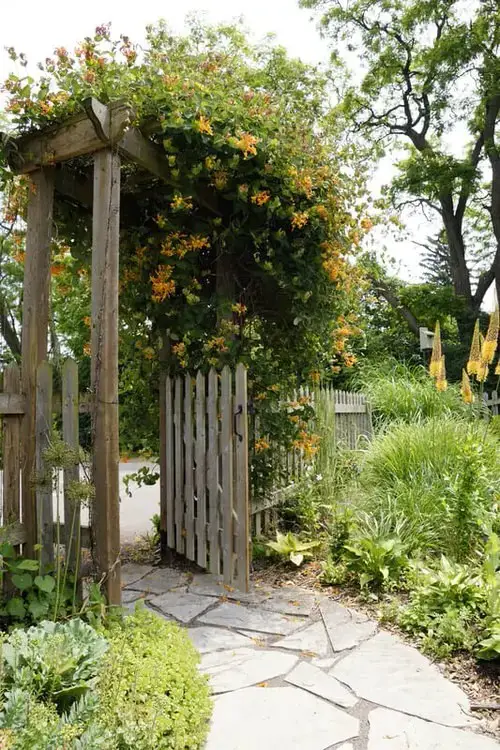
Botanical Name: Lonicera periclymenum
The fragrance of honeysuckle flowers is nostalgic and multiplies when dusk sets. It has more than 180 different species, and almost all are creepers. It is a huge vine that grows rapidly. A single honeysuckle plant can easily cover up a big sturdy pergola.
4. Passion Flower
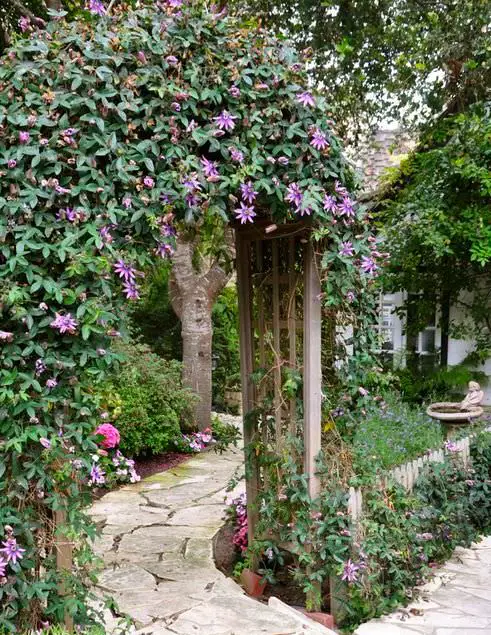
Botanical Name: Passiflora
The passion flower is a fast-growing, hardy perennial in moderate and warm climates. The heady fragrance, colorful flowers, and edible fruits make it one of the most desirable climbing plants you can have in your garden.
5. Jasmine
Botanical Name: Jasminum
The intense fragrance of the flower can be smelt from far far away! In warm and humid climates, jasmine blooms all year-round. In cooler zones, grow it as an annual or transfer it indoors in winter.
Check out the best Jasmine varieties here
6. Grape Vine
Botanical Name: Vitis
Truly one of the best climbing plants for pergolas, the grapevine will not only give shade and a bucolic sitting place but juicy grapes too.
7. Wisteria
Botanical Name: Wisteria sinensis
Wisteria is an aggressive grower, but it takes time to establish and it has a long life. If you have a large, sturdy pergola, it’ll look amazing on it. You’ll need to prune regularly to control its growth.
8. Trumpet Vine
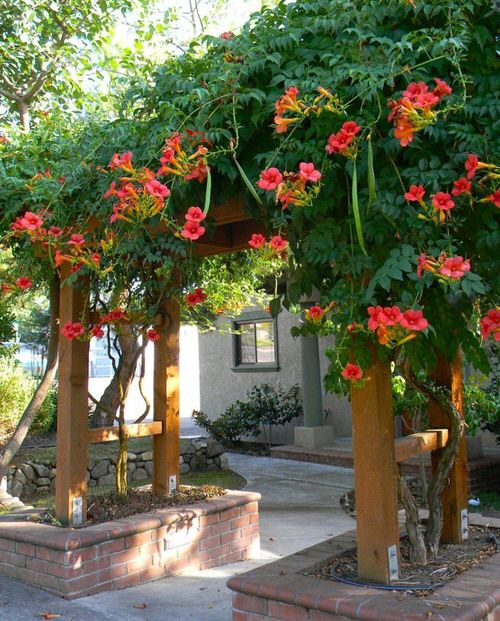
Botanical Name: Campsis radicans
Each trumpet vine flower can appear in different colors (orange, yellow, or red). The blooms attract bees and hummingbirds. This plant looks great on the arches, pergolas, and trellises, but in favorable conditions, it can be invasive as well.
9. Bignonia
Botanical Name: Bignonia
Another beautiful climber, its delicate bell-shaped flowers look great on pergolas. It is a fairly vigorous plant and tolerates mild to moderate frost.
10. Ivy
Botanical Name: Hedera helix
For the arbors, pergolas, and gazebos situated in the shade, Ivy is best, but it can be invasive as well. It is low maintenance, tolerates weather exploits, and provides a lush green color. To control it, you can grow it in large containers.
11. Bougainvillea
Botanical Name: Bougainvillea
The climbing varieties of bougainvillea are suitable for the pergolas, garden gates, and arches in USDA Zones 9-12. This plant loves a sunny position and heat and does not like wet feet. It comes in pink, red, yellow, and purple, along with many other shades.
12. Morning Glory
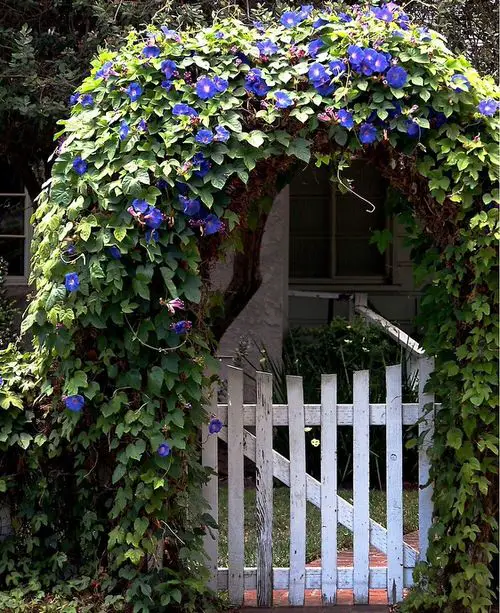
Botanical Name: Ipomoea
Morning glory vine is relatively easy to grow, and it perks up quickly—an excellent plant to cover up a pergola in a sunny position.
13. Kiwi
Botanical Name: Actinidia arguta
A kiwi vine takes a lot of space to grow. That is why it is one of the best pergola plants on our list. To get fruits from the kiwi plant, you’ll need to have both male and female plants for pollination.
14. Sweet Pea
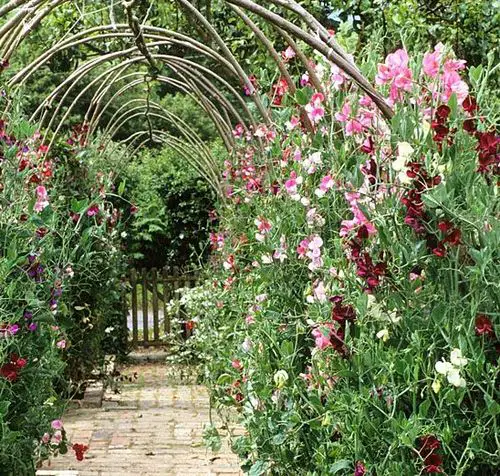
Botanical Name: Lathyrus odoratus
Don’t grow bush-type varieties if you are growing them over the pergola. Plant sweet peas in the sun and provide well-drained soil.
15. Rangoon Creeper

Botanical Name: Combretum indicum
The sweet-scented flowers of this vine come in bright orange color that matches well with its bright green foliage. It climbs easily and does best in part or full sun. It also attracts pollinators!
16. Bleeding Heart Vine

Botanical Name: Clerodendrum thomsoniae
The tropical bleeding heart vine is native to Western Africa. What makes it perfect for pergolas is its contrasting combination of dark green foliage and exotic white-red flowers! It is one of the best pergola plants you can grow.
17. Butterfly Pea
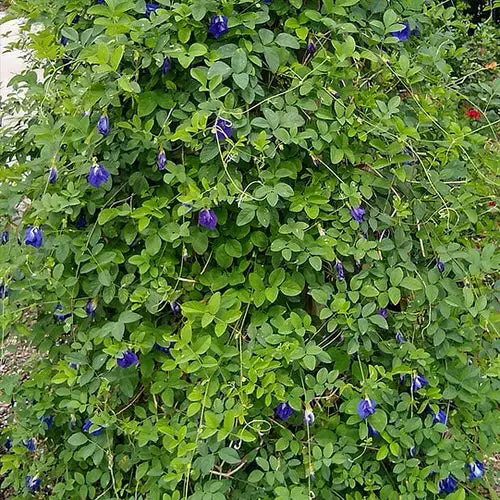
Botanical Name: Clitoria ternatea
Butterfly pea flowers are the best food source for butterflies. The most attractive thing about this vine is its bright deep blue flowers!
18. Golden Hops
Botanical Name: Humulus lupulus
A fast-growing vine that quickly covers up the trellises, pergolas, and arches. Golden hops can grow up to 15-20 feet long without any difficulty.
19. Climbing Hydrangea
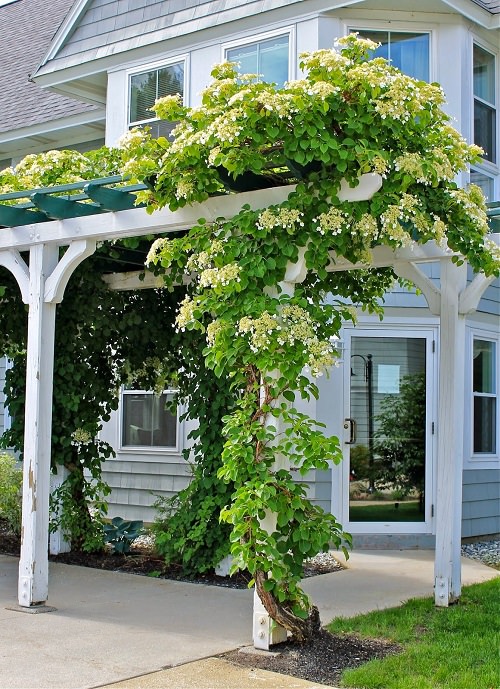
Botanical Name: Hydrangea petiolaris
Growing climbing hydrangea vine is rewarding due to its glossy heart-shaped foliage and fragrant white flowers that appear in clusters from spring to summer. It is a slow grower and requires training and pruning.
Learn to grow Hydrangea from cuttings here
20. Bower Vine

Botanical Name: Pandorea jasminoides
Native to Australia, this evergreen intertwining vine creates a dense mat of pink-white blooms and green foliage. It does well in full sun or partial shade in alkaline soil.
21. Dutchman’s Pipe
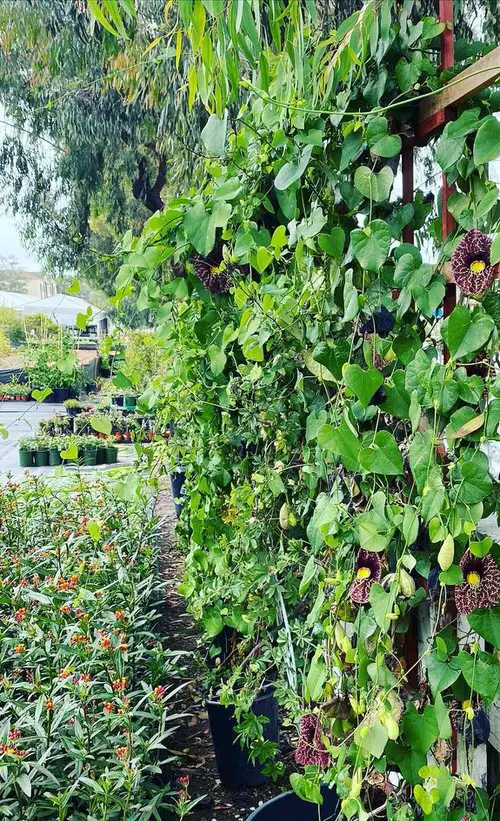
Botanical Name: Aristolochia Elegans
This vine produces one of the most exotic-looking flowers that look like Sherlock Holmes’ Pipe, the reason behind its bizarre name. You can also grow it in pots, it does best in partial sunlight.
22. Nasturtiums

Botanical Name: Tropaeolum majus
This climber grows up to 8-10 feet tall, and during summer and fall, it produces yellow, cream, orange, or a blend of apricot, salmon, peach, and scarlet blooms. Another interesting fact is both the leaves and flowers are edible!
23. Golden Trumpet
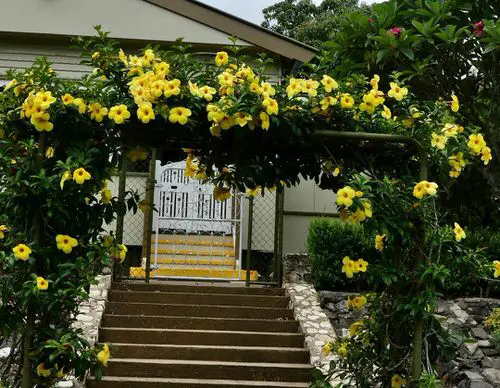
Botanical Name: Allamanda cathartica
If you like yellow flowers, then this is the vine to grow! It looks best on arbors and garden gates. For best growth, do make sure it gets bright sunlight.
24. Crimson Glory Vine

Botanical Name: Vitis coignetiae
The beautiful maroon-red foliage of the vine is a head turner! For the best color of the leaves, grow it in an area that gets sunlight all day long.
25. Flaming Glorybower

Botanical Name: Clerodendrum splendens
The red flowers of the vine match really well with its dark green foliage. Avoid keeping it in the harsh afternoon sun for long and choose a spot where it receives at least 6 hours of sunlight. It grows best in warm climates!
26. Tecoma Vine

Botanical Name: Tecoma
The fiery orange-red or yellow flowers of this vine can add a lot of drama to the space while bringing a tropical touch! Thanks to the vining nature, you can train it easily on the arbor for a wonderful display.
27. Black-Eyed Susan

Botanical Name: Thunbergia alata
While talking about aggressive vines, you just can’t ignore this one! The plant looks stunning with its yellow flowers on bright green foliage! It is quite easy to maintain, too.
28. Blue Skyflower

Botanical Name: Thunbergia grandiflora
The paper blue flowers of this vine look elegant with the light green foliage. To grow it well, make sure you provide it with the right support and plenty of sunlight.
29. Purple Hyacinth Bean

Botanical Name: Lablab purpureus
This vining annual is admired for its blooms, the purple hue embellishes the stems, foliage, flowers, and seed pods. It grows up to 10-15 feet tall and a 3-6 feet wide.
30. Scarlet Clock Vine

Botanical Name: Thunbergia coccinea
This beautiful vine looks amazing on pergolas with dark-green toothed leaves and bright red flowers hanging in clusters. The intense hue of blooms depends on the temperature.
31. Yellow Jessamine
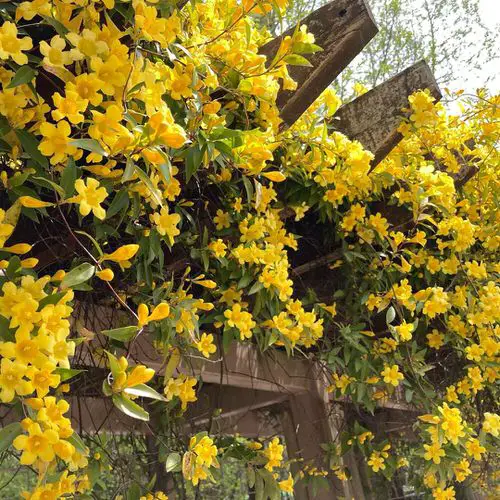
Botanical Name: Gelsemium sempervirens
Yellow Jessamine is loved for sweet-scented canary-yellow blooms that appear from February to May. It has a moderate growth till established completely.
32. Queen’s Wreath
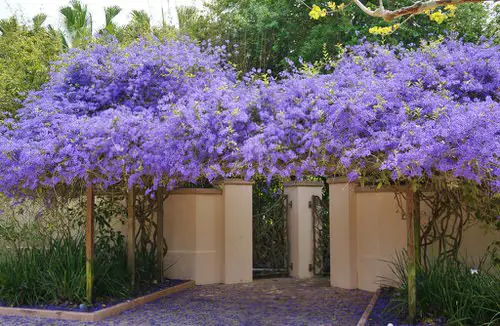
Botanical Name: Petrea volubilis
This charming climber has dangling long cones of purple-violet star-like flowers. The true purple flowers last for a couple of days and blue bracts stay for long gradually turning gray.
33. Mandevilla
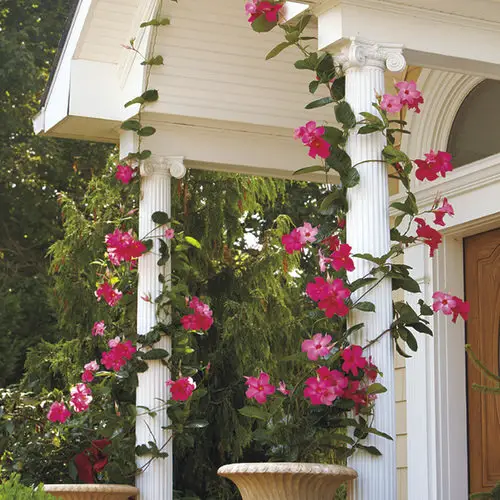
Botanical Name: Mandevilla spp.
Also known as rock trumpet, this flowering vine shows off fragrant five-petal blooms, it grows up to 3-10 feet tall and 3-4 feet wide making it one of the best pergola plants.
34. Cape Honeysuckle
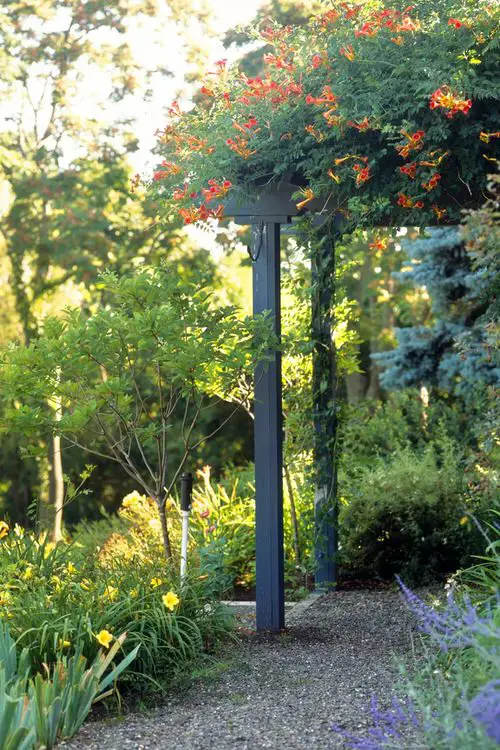
Botanical Name: Tecomaria Capensis
This perennial is an evergreen shrub, it has a climbing growth habit that makes it an apt choice for pergolas. It offers red-orange tubular flowers and glossy green foliage.
Check out the best plants to cover a fence here



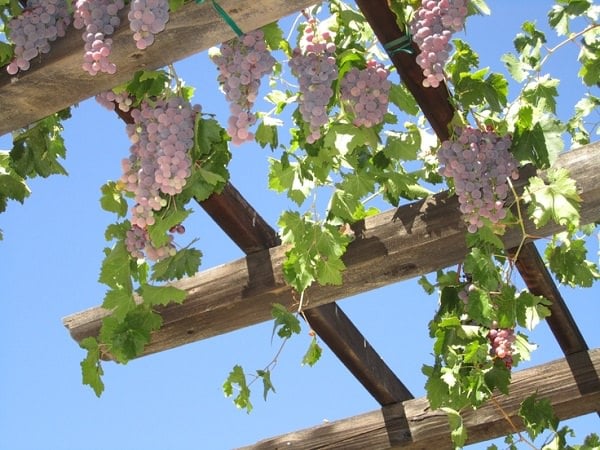
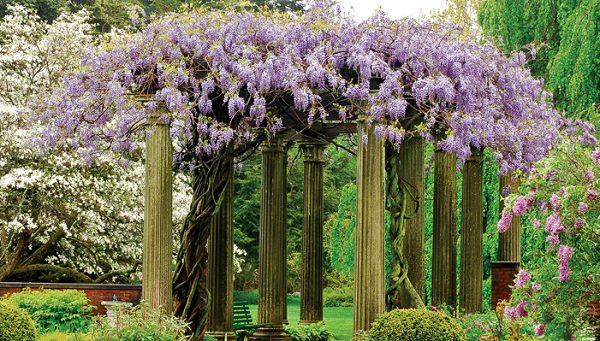

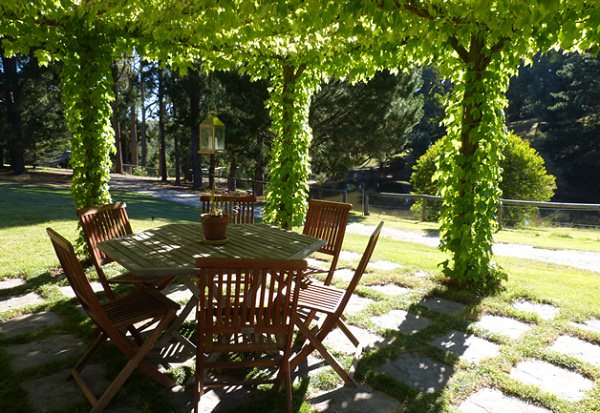

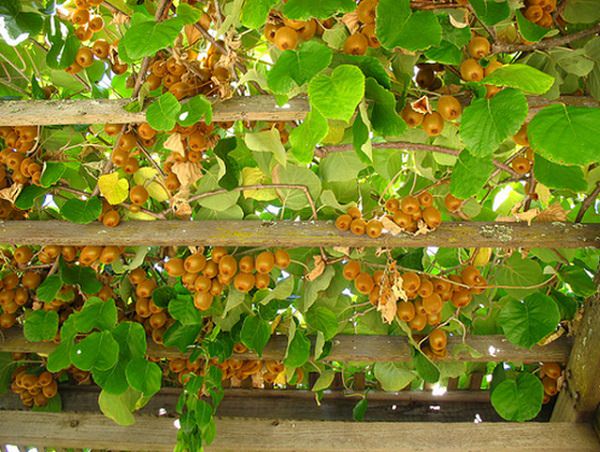
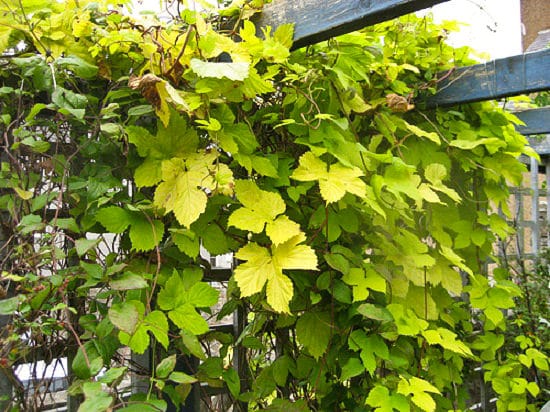

i need some names of plants that can tolerate heat (40 and over) in summer and cold in winter(frost), can you please help thx
Hi, it would be better if you were clearer? 40 Fahrenheit or Celsius? Also, please tell us the zone your area falls into?
Well, one would assume that if they were talking about the heat and said 40…they would mean Celsius. Just saying.
Rude and unnecessary. 40 Celsius is about 105 degrees Fahrenheit. Mentioning 40 and cold winter frost just sets up a confusing argument which is why the admin asked what zone. Sure you can always make assumptions but ass is always in assumption.
Have you ever heard of the purple king’s vine?
I totally agree with Coinages. Common sense!
It gets tp 100 in minnesota, nebraska, and kansas, in the summer. And they also get cold winters. California can be 100 and so can Texas and Miami
Which plants u need.
Shrubs, trees,palms,ground cover
i was surprised to see bleeding heart on this list….i have never seen bleeding heart climb anything…only seen it as a small bushy plant that dies back late summer and fall….i noticed there wasnt a picture of it climbing…is this a mistake?…i will google it to see if i can find pictures of a climbing variety…i love them and have a couple.
Hondo u know where I can get the tropical bleeding heart?
lazy s’s farm nursery carries a YELLOW one. look under dicentra is the vine section. i’m going to try to grow it.
Advice for growing my clematis as beautiful and full as that? Located within Zone 6.
I have a bare wall on the side of my house and thought about finding some sort of climbing plant to fill the empty space. Ideas would be appreciated!
I’ve grown many varietys but the only prolific ones were purple, single blossom types like mr president and jackmanni. My lawn guy kept mowing over the two, and you’ll need two to really cover..and I thought it would kill it, but trimming the dead vine to the ground in spring just made it lusher! That’s when I learned about what the Brits talk about in gardening..cutting plants to about a foot from the ground to rejuvenate them in spring. I’ve killed a few butterfly bushes cutting too early, but once, in zone three..I move a lot..I ‘stooped’ an entire ‘spirea, bridal wreath’ that had been crushed with snow, and it recover more beautiful than ever. Of course I give it gentle fertilizer through out. Good luck!
Megan – a climbing rose pairs well with a clematis. Use a sturdy trellis against the wall. Plant New Dawn Rose and Jackmanii at the base of the trellis.
I really enjoyed the article. I live on the Texas Gulf Coast what are your suggestions?
Thank you!
Hi Linda, due to mild winters you can grow many tropical vines. Madagascar jasmine and Rangoon creeper will do well. If you can find Indian clock vine (Thunbergia mysorensis), which is an absolute show stopper and one of the most beautiful vines, it grows well in warm climates.
I would be careful with trumpet vine. Yes, it is beautiful. I have one growing on an arch and it makes for a magnificent display in the summer. However, it is highly invasive, and you will find it popping up everywhere, including your neighbors’ yards. Just be sure you keep it off your house, because it will quickly find its way beneath your siding, in your crawl space, and anywhere else it can find an opening.
I couldn’t agree more, Cheryl! Every time I see trumpet vine on a list like this, I literally cringe!
I took out a trumpet vine last spring & it was the best decision I’ve made in regards to landscaping my yard. It was growing vigorously up a repurposed 6′ telephone pole along the side of my garage (about a foot away) & over onto the roof of garage. I agree with one thing in this article: it WAS beautiful when blooming, but the damage it was doing to the siding & shingles, not to mention overtaking the rest of the plants in the bed it was planted in, choking out some gorgeous clematis, wasn’t worth keeping it. And when trimming or cutting back, the disc-like suckers it uses to climb vertical surfaces takes the paint off with it (if it’s against a painted surface). It’s extremely strong, too, and can find it’s way into cracks or between sections of siding or shingles, damaging whatever it can get into!
Although I removed its main trunk, runners are still popping up from the ground, sometimes 10 feet away from the main trunk!
I’ve yet to conclude what wreaks most havoc in my yard: the trumpet vine or the mulberry trees unintentionally planted courtesy of bird droppings, which will spring up anywhere and everywhere the little seed-filled bird poop lands!
Thank you for posting this …I hope it is read by many before any one plants this creeper. My neighbor has one growing on a trellis next to our fence line. I agree it is lovely and I enjoy the humming birds that come to nest but that is where the beauty ends. It has literally taken over my lawn. We mow and within a day long vines are popped up everywhere. I have tried to plant a vegetable garden but its useless. It gets overwhelmed by all the vines that pop up from this extremely invasive plant. I could not believe it was listed with out a warning.
Yet another voice to add to the warning about trumpet vine! The vine had infested the yard in the house we live in before we got here. It damaged stucco, siding, trim, and window frames and was growing inside the windows. We have removed several trunks that remained seven inches in diameter to a depth of three and four feet below ground level before tapering to a width that we could use heavy-duty loppers on. It is susceptible to Roundup, though it typically takes multiple applications to kill it. I generally dig out each new start with a shovel to try to get as much of the underground runner as possible. I’ve been aggressively removing trumpet vines for four straight years, now, and I might eventually eradicate it. I consider it a noxious weed and would strongly encourage gardeners to choose to plant something less invasive.
Wish I had seen this before planting my trumpet vine. I had it for 14 years before I had to trim it. Then it grew a foot a day. It was impossible to keep up with. I went to the beach a week and it was out of control. Beautiful and loved the hummingbirds but the blooms made a mess every where and it is on a trellis beside my pool. Grew through the deck in all the flower beds and the yard. We took it down 2 years ago and still have it pop up in the deck. I never want another one. I miss the shade, we had a swing under it but felt like I was in a cave .
y’all, an excellent showstopper of a big billowy vine with racemes of purple pea-like flowers is dilochos lablab. there is a pink version, but people dont pass out at the sight of it. lablabs are annuals, dying back with frost where i live, southeast central oklahoma, zone 7b. but it grows like a crazy thing and blooms early. as i recall, it got to 8 or 9 feet, but my trellis was only 6 feet, so they may climb higher with support. they are twiners.
the common name is purple hyacinth bean. you get plenty of viable seed for next year, and even as big as these are, enough will germinate with no attention from you that it might as well be a deciduous perennial. i am putting in raised beds with lattices and will sure enough have these again.
i wish the author’s name showed on this page. I just got my mind changed about kiwi and jasmine, so back to the nursery catalogs.
now i gotta have bignonia THIS year.
What kind of vines or ground cover could you recommend to Las Vegas. REgion 9, something ever green with or without flowers. Thank you
I have a 4th year clematis that I trimmed to about 2 feet for the winter and this year it has taken over my patio, went up the string trellis I made and up over the beams of the patio and has dropped towards the ground. What would happen if I cut the clematis that is laying on the ground off. Can it be propagated, or will cutting it off ruin the remaining plant.
Find an article on ‘layering! It’s healthy to cut some things back. That’s the secret to those lushe English gardens! Be brave.
I am a little afraid of the bees with the flowers. Any suggestions for a NY climate?
Please keep in mind(if you have pets) that Jasmine is extremely toxic to dogs! ❤
http://www.aspca.org/pet-care/animal-poison-control/toxic-and-non-toxic-plants/jasmine
Thanks Jeff! I can leave mine to grow 🤗
Thanks for sharing this. I am glad is not toxic. We have pets and Jasmine.
Thank you for that information. Love jasmine but I also have a dog. That could be devastating!
Trumpet Vine is poisonous to dogs, as well.
JASMINE IS NOT TOXIC- I don’t think people are clicking on the link…but it is NOT toxic!
Make it 20 and add Dutchman’s Pipe. Awesome for covering a pergola, native to North America, and you’ll attract Pipeline Swallowtails!
OOOOOHHH! NOPE! NOT IN FL!!! It is HIGHLY invasive! And it STINKS when brushed up against! YUCK! It’s a HORRIBLE smell! Smells like rotting meat….which attracts flies to lay eggs!! It’s toxic- even to humans (KIDDOS!) AND it takes a LOT of repeat herbicides to control. If those are things you’re looking for…go ahead, haha. Maybe for the Adam’s Family haha.
I AM REFERRING TO DUTCHMAN’S PIPE…NOT SURE I WAS CLEAR ON THAT
Liked the article about climbing vines….
Please tell us which of these plants are actually invasive? I KNOW FOR A FACT that “Morning Glories” are.
We live in Zone 5 (about an hour West of Chicago), and we loved them while we had our pool. But in the last 4 years, we are still pulling up Morning Glories.
But I must say, they are GORGEOUS.
Readers please do your research before purchasing ANY plant you don’t personally know.
Trumpet Vine (Campsis radicans) species is extremely aggressive, i.e. a thug! Apparent the hybrid varieties are controllable.
Morning glories don’t grow well until it gets hot, this annual dies in freezing temps but reseed themselves abundantly.
Bleeding Heart (Dicentra spectabilis) is NOT a vine.
Totally agree with morning glories being invasive, but beautiful. I have been trying to get rid if them for about 4 years and they kerp returning.
How fast does ivy grow ? I’m located in NY
Hi Vasiliy, this article might be helpful.
The best place to get accurate, reliable information is your county extension office. They can offer plants suited to your climate, soil, and many other factors when growing. And it’s usually free.
try Rangoon Creeper – dies back in the winter in Zone 9B, but stunning and lovely scent
Hello. I reside in Los Angeles ,CA and for the past 3 yrs we’ve had some unusually cold and frosty winters. We had 4 potted honeysuckle at each corner of our pergola and lost one after last winter. By the time the plants have a chance to grow back nicely another winter hits so the plants never get a chance to grow onto and over the pergola. I’m thinking of replacing them with another flowering vine but not sure with what. Can u make some recommendations? My pots are approx 3′ h x 1′ w.
They all look amazing! Climbing flowers have ups and downs. they look great, they keep shadow in a sunny place, they smell wonderful, but, they also collect ants and bees, and they could be very toxic, especially to pets and small children.
Have a great day!
Hello all, I’m glad this group is active as I’m in urgent need for advise. I live in Cairo Egypt and just bought a house with a pergola however the land is not cultivated yet so I’m starting from zero. I have never planted before so I would prefer something easy to maintain. One important factor is that Cairo is a desert like climate which means daytime is warm and nights are cool, it hardly rains. It has a long hot summer from May until October (reaches up to 40 Celsius) and a mild winter from November to April. Thanks in advance people.
Mexican Flame Vine (Senecio confusus) would have merited this list as well. Ideal for the Gulf coasts, evergreen and produces near continual orange daisy like flowers. It is a twining vine cold hardy to zone 8 or 9 and excellent for humming birds, butterflies and other pollinators. It is also highly drought tolerant once established and grows about 20 feet in all directions. Great plant to send up a tall Palm tree trunk just don’t allow it to overtop the palm fronds and prune back to about 2m if you are expecting a hurricane. Propagates itself easily wherever it touches the ground and by air layering, mine is currently growing 3 inches per day at the end of September here in the most southern tip of Texas. Mine is being used as a nectar planting in conjunction with milkweeds for the Monarch and Queen butterflies. Reportedly this plant does well in the Arizona deserts so would likely be well suited to the Middle East(for Amr) with supplemental watering until it is well established.
The photos are amazing. My favourite pergola plant is Honeysuckle. I guess it is Brown’s Honeysuckle ‘Dropmore Scarlet’
Is there anything for Zone 11 desert (with irrigation) that is evergreen but doesn’t need a supporting structure? I would like to use two trees, say for example laurels, and create an archway over my front entrance sidewalk. City bylaws prevent us from putting in anything structural over 5′ high so I was hoping to meld two tall evergreens together in a 10′ high archway and keep them trimmed.
I had been thinking Jasmine because fragrance would be a bonus, but worry that they will not be tidy looking. They will take the heat though; up to 117F in the summer.
Pink Queen Ann’s Wreath grows well in Tucson and up to 100+ degrees. It will die back with a winter freeze but pops right back up in spring with an incredible show of flowers. I have it climbing a mesquite tree in my yard and it gets way up there and looks beautiful. It will also cover a wire fence or trellis nicely. It also comes in white. I believe it is native to Mexico. Good luck! Oh, it will draw bees, but I don’t mind that.
great pics got lots of ideas thanks!
This article has been wonderful. I’m in Northern California. Summers are Hot and winters have been freezing this last year. I have a white fence I want to cover. I was thinking Jasmin but just learned it toxic to dogs. I think honeysuckle is beautiful but seems some have had. It such great luck with it. Any suggestions for what vine could take the summer and winter but aren’t tonic to dogs or kids( I have 3 :) ) and angel good too !
Thanks
I must have been a Vineyard owner in a past life because I love “grapevines”! Their big green leaves are heaven to me. I’m more about greenery than flowers. Their growing on my chain link fence, pergola, across my back patio and Breakfast patio. And I have illuminated them all with c-9 clear christmas lights. It’s the perfect lighting. You can find my photos @ Pinterest, Hometalk, Houzz & or my Facebook. Just search my name Melody Wagner or Melody Drinkwater Wagner. I hope you enjoy the photos. <3
We built a pergola and now I’m looking to plant something to vine over it. Must be able to stand Minnesota winters. Any ideas
Morning glory. Its a beautiful vining plant that is very low maintenance and grows really fast. I live in Michigan and these grow very well here.
I live in Minnesota so need a hearty vine that can handle winters,…,any suggestions?
I USED TO LIVE IN MN IN TWIN CITIES. MORNING GLORIES MIXED WITH MOON FLOWERS ARE ABSOLUTELY PERFECT! MOON FLOWERS SMELL AMAZING IN THE EVENINGS…AND THE FLOWERS ARE GORGEOUS AS WELL AS THE FOLIAGE!
Can I grow a combination of plants? I am thinking Roses and jasmine. I live in zone 9, gulf coast.
YEP! Clematis is ok, but passionflowers vine and jasmine are PERFECT! They smell AMAZING, they are BEAUTIFUL, and are basically NO work here when established!
ALSO RECOMMEND Petrea volubilis Family: Verbenaceae; Common Names: Queen’s Wreath, Petrea, Purple Wreath, Sandpaper Vine
THEY GROW UP TREES, TRELLIS OR YOU CAN TRAIN AS A “TREE”. IT IS WOODY THOUGH, SO ENSURE YOU HAVE ENOUGH SUPPORT!
Hi
I believe I’m in zone 3. Swift Current SK Canada.
My yard faces south. Well treed on south side.
What r the best shade climbing plants, bushes and Hydrangea to plant?
Just be sure whatever u grow it’s not a host plant for butterflies. Your beautiful vines will be gone. Like my passion vines.
I am more interested in a climber which gives a dence shade during hot summer 45 + celsius and shead its leaves for cold winters 6 degree so that to enjoy the sun. Just like grapes but am looking for other alternatives
BEWARE – Morning glories are a complete nightmare plant. It will take over your yard in a blink of the eye. I’ve heard it can grow 2 feet a day and it sends out shoots in every direction. I tried everything under the sun to get rid of them – every chemical – every suggestion – tried to cement over the root – EVERYTHING!!! Thankfully I moved away from that nightmare, the first thing I looked for in a new home was a lack of this type of plant. Good luck!
Hi I’m in Iowa more up north by SD and Nbr what will survive well if anything at all ? Would I need to replant every year? New to gardening need advice thanks so much love viny plants and flowers
Beware of the passion flower too, ask your neighbors if they like them before you plant one because they will all be battling them too. They grow like crazy here in florida
DO NOT PLANT MORNING GLORY! It will take over everything and your neighbors garden and is sooo hard to get rid of! It strangles other plants too. Not a good choice!
YOU forgot PYROSTEGIA VINE. It is a beautiful orange or red vine
Is there a climbing plant that is evergreen?
*WARNING* Morning Glory, highly recommend growing in a pot.
Morning Glory is a beauty of a climbing vine, but it’s beauty is to deceive. I had never seen so many roots until I planted Morning Glory in-ground in a small part of a large backyard in April. That same year by July, you couldn’t see any, overtook and killed many of flowering plants, bushes, trees, high cable wires, electrical wires, electrical post and everything that was in it’s way in a large backyard. Morning Glory has trillions of roots that are extremely difficult to get rid off because most of it’s roots are very solid, and most more than 4 inches thick that instantly procreate even more roots. Same year in August, it was trimmed, and it was a Morning Glory bomb explosion all over my large backyard, it got even more bigger. Uuuuugh!
I’m looking for the name of a White trumpet lily that blooms all summer; not an Easter lily and not a day lily. The name sounds like a man’s name as in Samuel johnson. Anyone know?
I was very surprised that there wasn’t mention of Wisteria in the replies. This vine is absolutely gorgeous, slow growing and can be unruly without attention but more the worth any trouble. Once this plant is established it is a show stopper with it’s delicate blooms and lovely scent. Highly recommended.
Hi I am a gardener and I leave in Texas I have most all the vines you mentioned in the article. The one didn’t like the zone 8 is bleeding heart,
Grapevines usually fruit from midsummer to early autumn. By growing them up a pergola, you can enjoy the pendulous fruits hanging down from the canopy. Provides a good, dense canopy for shade. Find out how to plant a grapevine outdoors .
The bee-friendly blooms of passion flowers are spectacular and have an exotic appearance, while plump orange fruits extend its interest. Best grown in full sun or partial shade in moist, well-drained soil.
The bee-friendly blooms of passion flowers are spectacular and have an exotic appearance, while plump orange fruits extend its interest. Best grown in full sun or partial shade in moist, well-drained soil.
Thumbergia, a bluish – purple floral vine, also know as the Blue-Sky-Vine here in northern Floridai, is a beauty. The color resembles that of a Tansinite. If you have a porch, use twine to direct it and completely cover two sides.
I live in southern NJ and planning a pergola for a full sunny area. I was thinking trumpet vine but read that it is invasive. Always wanted a wisteria but I’m concerned it will damage the slate patio under the pergola. So, what would you recommend?